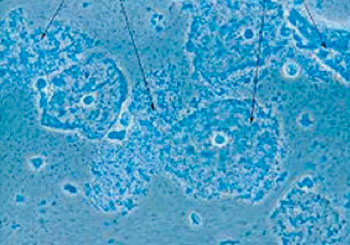Microarray Test Detects Pathogenic Shifts in the Taxonomic Distribution of Vaginal Bacteria
By LabMedica International staff writers
Posted on 01 Apr 2015
A team of Italian microbiologists has developed a microarray-based diagnostic tool that monitors the vaginal bacteria population and alerts the clinician to changes in taxonomic distribution that are characteristic of bacterial vaginosis.Posted on 01 Apr 2015
Under normal conditions the population of bacteria in the vagina is generally dominated by lactobacilli that confer antimicrobial protection and play a crucial role in health. Bacterial vaginosis (BV) is the most prevalent lower genital tract infection in women in reproductive age and is characterized by a shift in the relative abundance of Lactobacillus spp. to greater abundance of strictly anaerobic bacteria such as Gardnerella vaginalis, Atopobium vaginae, Mycoplasma hominis, various species of Prevotella and others.

Image: Micrograph of bacterial vaginosis—cells of the cervix covered with rod-shaped bacteria, Gardnerella vaginalis (arrows) (Photo courtesy of Wikimedia Commons).
Investigators at the University of Bologna (Italy) have reported the development of a microarray based test system that they call "VaginArray". This assay was based on 17 DNA probe sets, each being specific for one of the representative bacterial species inhabiting the vaginal ecosystem. Each set was designed to be complementary to the "variable region" of the 16S rRNA of its target gene and the match must be exact in order to register as positive. The target bacteria were identified and quantified by measuring the fluorescence intensity produced by each probe set.
In practice, the entire probe set properly recognized the specific targets and showed an overall sensitivity of 6 to12 nanograms per each probe. As a practical exercise the VaginArray was applied to assess the efficacy of rifaximin vaginal tablets for the treatment of BV. The investigators analyzed the vaginal bacterial communities of 22 BV-affected women treated with 25 milligrams/day rifaximin vaginal tablets for five days. Results showed the ability of rifaximin to reduce the growth of various BV-related bacteria. Furthermore, an increase of Lactobacillus crispatus was observed in the subset of women who maintained remission after one month of therapy.
"Our microarray could be used to study alterations of the vaginal ecology associated with gynecologic disorders and to assess the impact of therapeutic agents on the vaginal microbiota," said senior author Dr. Beatrice Vitali, professor of pharmacy and biotechnology at the University of Bologna.
The paper describing VaginArray was published in the March 2, 2015, online edition of the journal Antimicrobial Agents and Chemotherapy.
Related Links:
University of Bologna














